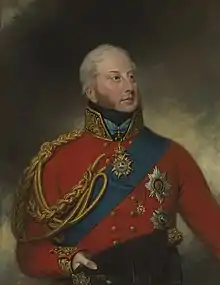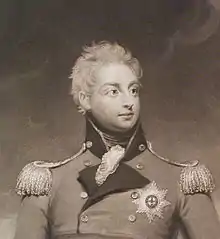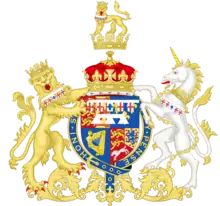Prince William Frederick, Duke of Gloucester and Edinburgh
Prince William Frederick, Duke of Gloucester and Edinburgh, KG, GCB, GCH, PC, FRS (15 January 1776 – 30 November 1834) was a great-grandson of King George II of Great Britain and the nephew and son-in-law of King George III. He was the grandson of both Frederick, Prince of Wales (George II's eldest son), and Edward Walpole. Prince William married Princess Mary, the fourth daughter of George III.
| Prince William Frederick | |
|---|---|
| Duke of Gloucester and Edinburgh | |
 The Duke of Gloucester, c. 1810s | |
| Born | Prince William Frederick of Gloucester 15 January 1776 Teodoli Palace, Rome, Papal States |
| Died | 30 November 1834 (aged 58) Bagshot Park, Surrey, England |
| Burial | 11 December 1834 |
| Spouse | |
| House | Hanover |
| Father | Prince William Henry, Duke of Gloucester and Edinburgh |
| Mother | Maria Walpole |
Early life

Prince William Frederick was born on 15 January 1776 at Palazzo Teodoli in via del Corso, Rome.[1] His father was Prince William Henry, Duke of Gloucester and Edinburgh, the third son of the Prince of Wales. His mother, Maria, was the illegitimate daughter of Edward Walpole and granddaughter of Robert Walpole. As a great-grandson of George II he held the title of Prince of Great Britain with the style His Highness, not His Royal Highness, at birth. The young prince was baptized at Teodoli Palace, on 12 February 1776 by a Rev Salter. His godparents were his father's cousin and cousin-in-law, the Duke and Duchess of Saxe-Gotha-Altenburg; and the Duke of Gloucester's second cousin, the Margrave of Brandenburg-Ansbach.[2]
During his stay in Stockholm in 1802–1803, William's interest and rumoured affair with Aurora Wilhelmina Koskull attracted a lot of attention, and he reportedly had plans to marry her. Queen Charlotte recalled that William said of Koskull: "If she was your daughter, I would marry her!"[3]
William was admitted to the University of Cambridge (Trinity College) in 1787, and granted his MA in 1790.[4] He set up his London home at 31 Upper Grosvenor Street, Mayfair. [5] On 25 August 1805, Prince William's father died, and he inherited the titles Duke of Gloucester and Edinburgh and Earl of Connaught.
From 1811 until his death William was Chancellor of the University of Cambridge.[4] He was offered the throne of Sweden in 1812 by some members of the Swedish nobility, but the British government would not allow it; the French marshal Jean-Baptiste Bernadotte was eventually selected to become King Charles XIV John.
Military career
On the outbreak of war with France in 1793, Prince William was commissioned as a captain in the 1st Regiment of Foot Guards,[6] with the rank of lieutenant-colonel in the Army, backdated to March 1789.[7] He was promoted to colonel on 24 February 1794,[8] and served in the Flanders campaign from March to May that year.[7] On 26 February 1795 he was promoted to major-general.[9] From September to October 1799 he commanded a brigade of Foot Guards in the Helder Expedition,[7] for which he was mentioned in despatches.[10] On 13 November 1799 he was promoted lieutenant-general, and held various home commands[7] before being promoted to general on 25 April 1808.[11] On 26 May 1816 he was promoted field marshal.[12]
He was colonel of the 115th Regiment of Foot (Prince William's) from 1794,[13] then colonel of the 6th Regiment of Foot from 1795[14] and finally colonel of the 3rd Regiment of Foot Guards from 1806[15] until his death.[16]
Marriage
On 22 July 1816, Prince William married his first cousin Princess Mary, the fourth daughter of King George III. The marriage took place at St. James's Palace, London. On that day, the Prince Regent granted the Duke the style of His Royal Highness by Order in Council.[17]
The Duke and Duchess of Gloucester lived at Bagshot Park in Surrey. They had no children together; they had married when both were 40. The Duke had been encouraged to stay single, so that there might be a suitable groom for Princess Charlotte of Wales, who was expected to succeed to the throne, if no foreign match proved suitable; she had married Prince Leopold of Saxe-Coburg ten weeks earlier.[18]
Later life

William was active in many walks of life, and on 27 April 1822 he chaired the first Annual General Meeting of London's new United University Club.[19] In politics, "the Duke generally voted with the Whigs"[20] but only entered the House of Lords rarely and voted on few of the great issues of his time. He did advocate the abolition of slavery, and he supported Caroline of Brunswick and Prince Augustus Frederick, Duke of Sussex, against King George IV.[21] In the 1790s, William and his friends John Opie - who had painted the Duke's portrait - and his wife Amelia Opie were regular guests at Earlham Hall, the seat of the Gurney family who, like the Duke and the Opies, were Whigs and abolitionists. Upon John Opie's death, the Duke wrote a letter of sympathy to Amelia saying he was glad Royal etiquette allowed him to follow the Opie funeral procession in his carriage to St. Paul’s Cathedral where Opie would be buried.[22][23][24]
The Duke of Gloucester kept more state than the King; he never permitted a gentleman to be seated in his presence (which King George did as an exceptional favour) and expected to be served coffee by the ladies of any party he attended, and that they would stand while he drank it.[25] The general estimate of his capacity is given by his nickname, "Silly Billy"; he was also called "Slice of Gloucester" and "Cheese",[21] a reference to Gloucester cheese.
Because of the unequal character of his parents' marriage, the Duke was excluded from the House of Hanover, being considered only a British prince. For instance, he and his sister Sophia were not listed in the genealogical listing of the electoral house of Hanover in the Königlicher Groß-Britannischer und Kurfürstlicher Braunschweig-Lüneburgscher Staats-Kalender. He was also not invited to sign the family compact of the house of Brunswick-Lüneburg in 1831, which means that he was not considered an agnate of the royal (electoral) house in Germany.[26]
The Duke died on 30 November 1834 at Bagshot Park, and was buried in St. George's Chapel, Windsor.[27]
Connaught Place, Connaught Street and Connaught Square in the Tyburnia district north of London's Hyde Park all take their name from his subsidiary title the Earl of Connaught. The area was developed in the 1820s and still features much of its original Regency architecture.[28]
Honours
- KG: Knight of the Garter, 16 July 1794
Arms

William was granted use of his father's arms (being the arms of the kingdom, differenced by a label argent of five points, the centre bearing a fleur-de-lys azure, the other points each bearing a cross gules), the whole differenced by a label argent (or azure).[29]
Ancestry
| Ancestors of Prince William Frederick, Duke of Gloucester and Edinburgh | |||||||||||||||||||||||||||||||||||||||||||||||||||||||||||||||||||||||||||||||||||||||||||||||||||||||||||||||||||||||||||||||||||||||||||||||||||||||||||||||||||||||||||||||||||||||||||||||||||||||||||||||||||||||||||||||||||||||||||||||||||||||||||||||||||||||||||||||||||||||||
|---|---|---|---|---|---|---|---|---|---|---|---|---|---|---|---|---|---|---|---|---|---|---|---|---|---|---|---|---|---|---|---|---|---|---|---|---|---|---|---|---|---|---|---|---|---|---|---|---|---|---|---|---|---|---|---|---|---|---|---|---|---|---|---|---|---|---|---|---|---|---|---|---|---|---|---|---|---|---|---|---|---|---|---|---|---|---|---|---|---|---|---|---|---|---|---|---|---|---|---|---|---|---|---|---|---|---|---|---|---|---|---|---|---|---|---|---|---|---|---|---|---|---|---|---|---|---|---|---|---|---|---|---|---|---|---|---|---|---|---|---|---|---|---|---|---|---|---|---|---|---|---|---|---|---|---|---|---|---|---|---|---|---|---|---|---|---|---|---|---|---|---|---|---|---|---|---|---|---|---|---|---|---|---|---|---|---|---|---|---|---|---|---|---|---|---|---|---|---|---|---|---|---|---|---|---|---|---|---|---|---|---|---|---|---|---|---|---|---|---|---|---|---|---|---|---|---|---|---|---|---|---|---|---|---|---|---|---|---|---|---|---|---|---|---|---|---|---|---|---|---|---|---|---|---|---|---|---|---|---|---|---|---|---|---|---|---|---|---|---|---|---|---|---|---|---|---|---|---|---|---|---|
| |||||||||||||||||||||||||||||||||||||||||||||||||||||||||||||||||||||||||||||||||||||||||||||||||||||||||||||||||||||||||||||||||||||||||||||||||||||||||||||||||||||||||||||||||||||||||||||||||||||||||||||||||||||||||||||||||||||||||||||||||||||||||||||||||||||||||||||||||||||||||
See also
References
- "...the insignificant palaces, Fiano, Verospi, and Teodoli..." (Augustus Hare, Walks in Rome vol. i, 1903 p. 46).
- Yvonne's Royalty Home Page: Royal Christenings Archived 6 August 2011 at the Wayback Machine. Users.uniserve.com. Retrieved on 15 July 2012.
- Cecilia af Klercker (1927). Hedvig Elisabeth Charlottas dagbok VII 1800–1806 (The diaries of Hedvig Elizabeth Charlotte VII 1800–1806) (in Swedish). P.A. Norstedt & Söners förlag. OCLC 68029346.
- "Gloucester, H.R.H. Prince William Frederick, Duke of (GLCR787WF)". A Cambridge Alumni Database. University of Cambridge.
- "Upper Grosvenor Street: South Side Pages 231-238 Survey of London: Volume 40, the Grosvenor Estate in Mayfair, Part 2 (The Buildings). Originally published by London County Council, London, 1980". British History Online. Retrieved 13 July 2020.
- "No. 13501". The London Gazette. 9–12 February 1793. p. 119.
- T. A. Heathcote, The British Field Marshals 1763–1997: A Biographical Dictionary (1999), p. 302.
- "No. 13625". The London Gazette. 18–22 February 1794. p. 160.
- "No. 13755". The London Gazette. 24–28 February 1795. p. 187.
- "No. 15186". The London Gazette. 24 September 1799. p. 974.
- "No. 16142". The London Gazette. 3–7 May 1808. p. 622.
- "No. 17139". The London Gazette. 25 May 1816. p. 991.
- "No. 13650". The London Gazette. 29 April – 3 May 1794. p. 395.
- "No. 13828". The London Gazette. 3–7 November 1795. p. 1140.
- "No. 15923". The London Gazette. 27–31 May 1806. p. 662.
- "No. 19220". The London Gazette. 12 December 1834. p. 2243.
- Royal Styles and Titles – 1816 Royal Warrant. Heraldica.org. Retrieved on 15 July 2012.
- Complete Peerage, "Duke of Gloucester", citing the obituary of Princess Mary in the Annual Register of 1857.
- Club History Since 1821 Archived 31 December 2007 at the Wayback Machine at oxfordandcambridgeclub.co.uk (accessed 9 January 2008)
- Campbell, Thomas (1835). "New Monthly Magazine". 43. Henry Colburn: 135.
In politics, the Duke generally voted with the Whigs...
{{cite journal}}: Cite journal requires|journal=(help) - A. W. Purdue, ‘William Frederick, Prince, second duke of Gloucester and Edinburgh (1776–1834)’, Oxford Dictionary of National Biography, Oxford University Press, September 2004; online edn, May 2009.
- Farrant, A. (2015). Amelia Opie and the Martineaus (PDF). Martineau Society. Retrieved 23 July 2023.
This was Prince William Frederick, the Duke of Gloucester, a staunch advocate of the abolition of slavery. Amelia had first met him in the 1790s, when he was a guest of the Gurneys of Earlham on several occasions. Louisa and Richenda Gurney wrote glowing accounts of him in their journals, describing him as sociable and agreeable. John Opie's last portrait was of the Duke; it was completed just before his death. The Duke wrote a letter of sympathy to Amelia and said he was glad Royal etiquette allowed him to follow the Opie funeral procession in his carriage to St. Paul's Cathedral....When Amelia wrote her Memoir of John Opie to accompany the publication of his lectures on painting, the subscribers included Harriet's uncles David, Peter and John and a Philip Meadows Taylor of Liverpool (possibly the son of Richard and Margaret Taylor and therefore cousin to these uncles). Prince William Frederick, Duke of Gloucester, headed the list of 206 subscribers.
- "William Frederick (1776–1834), 2nd Duke of Gloucester [by] John Opie (1761–1807)". ArtUK. ® ArtUK. Retrieved 23 July 2023.
- Keen, P. (2020). The Popular Radical Press in Britain, 1811-1821. Taylor and Francis. p. 408. Retrieved 23 July 2023.
Richard Gurney was raised in a Quaker family as a committed Whig and was in favour of criminal law reform and parliamentary reform . He eventually became senior partner of his family's banking firm in Norwich
- Complete Peerage, "Duke of Gloucester"
- Styles of the members of the British royal family
- "Royal Burials in the Chapel since 1805". College of St George - Windsor Castle. Retrieved 5 March 2023.
- Bebbington, Gillian. London Street Names. Batsford, 1972. p.96
- Marks of Cadency in the British Royal Family. Heraldica.org. Retrieved on 15 July 2012.